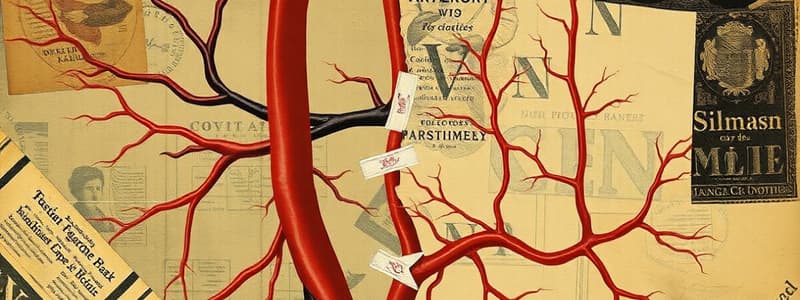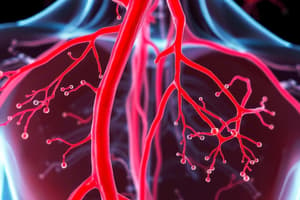Podcast
Questions and Answers
Which characteristic is unique to arteries compared to veins?
Which characteristic is unique to arteries compared to veins?
- Have a large diameter lumen to facilitate blood flow
- Contain valves to ensure unidirectional blood flow
- Have a thick outer wall to withstand high pressure (correct)
- Return deoxygenated blood to the heart
Which statement accurately describes the function of veins?
Which statement accurately describes the function of veins?
- Veins have muscular walls that can contract to increase blood pressure.
- Veins carry oxygenated blood away from the heart to organs.
- Veins contain valves that aid in preventing backflow of blood. (correct)
- Veins are responsible for generating a pulse with each heartbeat.
What distinguishes the pressure conditions in arteries from those in veins?
What distinguishes the pressure conditions in arteries from those in veins?
- Arteries maintain a smooth flow without pulse, unlike veins.
- Veins experience fluctuating pressure caused by heartbeat.
- Blood in arteries is at high pressure due to the pumping of the heart. (correct)
- Arteries operate under low pressure while veins are under high pressure.
How do the structural differences of veins facilitate their function?
How do the structural differences of veins facilitate their function?
Which function of arteries is NOT performed by veins?
Which function of arteries is NOT performed by veins?
Which statement accurately describes the structure of capillaries?
Which statement accurately describes the structure of capillaries?
What role do capillaries play in the circulatory system?
What role do capillaries play in the circulatory system?
How do substances move in and out of capillaries?
How do substances move in and out of capillaries?
Which of the following best explains the significance of capillary networks?
Which of the following best explains the significance of capillary networks?
In the context of the circulatory system, which statement about arterioles is correct?
In the context of the circulatory system, which statement about arterioles is correct?
Flashcards
Arteries vs. Veins: Structure
Arteries vs. Veins: Structure
Arteries have thick walls with muscle and elastic fibers, narrow lumens, and carry blood away from the heart. Veins have thin walls, large lumens, and carry blood toward the heart.
Artery Function
Artery Function
Carry oxygenated blood away from the heart; except pulmonary artery which carries deoxygenated blood.
Vein Function
Vein Function
Return deoxygenated blood to the heart; except pulmonary vein which carries oxygenated blood from lungs.
Artery Wall Thickness
Artery Wall Thickness
Signup and view all the flashcards
Vein Valves & Blood Flow
Vein Valves & Blood Flow
Signup and view all the flashcards
Capillary function
Capillary function
Signup and view all the flashcards
Capillary structure
Capillary structure
Signup and view all the flashcards
Capillary network
Capillary network
Signup and view all the flashcards
Artery-vein connection
Artery-vein connection
Signup and view all the flashcards
Blood vessel types
Blood vessel types
Signup and view all the flashcards




